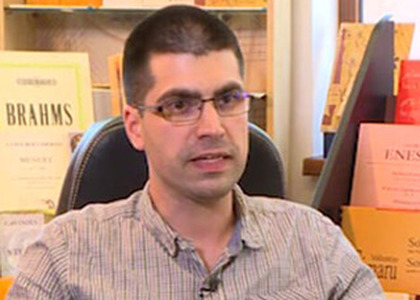> Interviews

Interview with Matei Bănică, “Grafoart” Association director
The "Dinu Lipatti" House is a part of the national heritage and has been put up for sale in the hope of saving this important cultural monument. The Grafoart Association appeals to the institutions, artists, music lovers, and the media for support and to help initiate a fundraising campaign. The director of the Association, Matei Bănică is here to share more details with us.
Matei Bănică, the future of the "Dinu Lipatti" House is once again uncertain, as it has been put up for auction through forced execution after an initial attempt to sell it in 2016. From the information we have, we know that the sale does not involve the entire building, but rather an essential component of it-a four-room apartment that includes the ground floor. What do you know about this? Specifically, what is being put up for auction?
It is about Dinu Lipatti house on Lascăr Catargiu Boulevard, Bucharest. It is a very valuable area from the perspective of land value. The apartment being sold is the main part of the house and comes with the entire yard of Dinu Lipatti's property. From my point of view, the issue lies with the high land value in this area, rather than the valueof the house itself. The house is extremely beautiful, it is a house with soul and history, built by Lipatti's grandfather, Constantin. The building was designed by Petre Antonescu, but the very small size of the building would not give it such value, so my fears and those of the musicians' guild are that the value of the land will lead to the illegal demolition of the house and the construction of a much taller building to justify the investment.
What would happen if this property were purchased by someone who no longer wishes to maintain its public and cultural purpose, as it istoday? What would it mean from a cultural and historical perspective to lose this space, which is dedicated to the memory of Dinu Lipatti?
In my view, removing it from the cultural circuit would be a huge loss for musicians. For example, just last night, as it marked 108 years since the birth of Dinu Lipatti, there was a recital by pianist Viniciu Moroianu with works by Lipatti and Enescu, a small, intimate chamber recital, which was very successful and something that must continue to happen. The current situation, where the building belongs to the Museum of Bucharest, is, in my opinion, very good. It is right that it belongs to the museum. Even better would be if it were owned by the museum, the Ministry of Culture, or the city hall, but in any case, it should remain a cultural space. Unfortunately, my attempts to raise awareness at the Ministry of Culture, the city hall, and the district city hall have so far gone unanswered. I haven't even received a reply. They hide behind the 30-day deadline, saying, "we will respond". Unofficially, they tell me: "Let's wait and discuss." But time is very short, so the Grafoart Association has launched a fundraising campaign in the hope of achieving two results. First, that we will raise at least part of the amount needed to buy the house, a part that will be completed by one of the state institutions, the city hall, or the Ministry of Culture; and secondly, to raise as much awareness as possible in an effort to wake up the state institutions.
Is there a minimum amount required to secure the future of Dinu Lipatti House?
From the perspective of donations, there is no minimum amount required. No matter how small the donations are, it is better because they show, through the number of donors and the interest from civil society in saving this house, an interest that is a very important argument when communicating with the authorities, where numbers matter.
What are the ways people can contribute to saving the Lipatti House? Are we talking about bank accounts or online donations?
Donations can be made to the association's account via payment order in Lei, Euro, or US dollars, by card payment, either in Lei or Euro, and through the Bursa Binelui platform, where we have this project listed. People can go there, read more details about the project, and at the end, they can donate. I repeat, any amount, no matter how small, because it is important for us to have it as an argument, not just the amount itself.
What type of support do you hope to receive from public institutions and the private sector?
The correct attitude from public institutions would be to purchase this building, which would be the simple and beautiful solution, and w ecould close the story of this house with a smile, leaving it within the public circuit. From the private sector, primarily, support for spreading the project as widely as possible and, secondly, material support.
What response have you received so far from the public and the artistic community?
The artistic community has been very alarmed by this news. Everyone was surprised that the issue wasn't resolved as it appeared nine years ago when it was first put up for auction. From a legal standpoint, the house is now rented by the Museum of Bucharest from the private owner, who is under forced execution, and my hope is that in the near future, it will remain the property of the museum.
Translated by Adina Gabriela Văcărelu,
University of Bucharest, Faculty of Foreign Languages and Literatures, MTTLC, year I
Corrected by Silvia Petrescu














